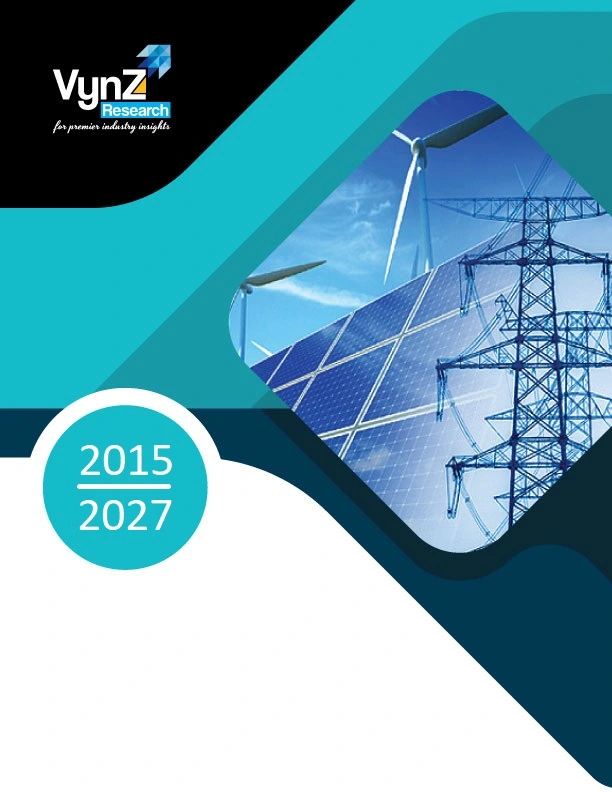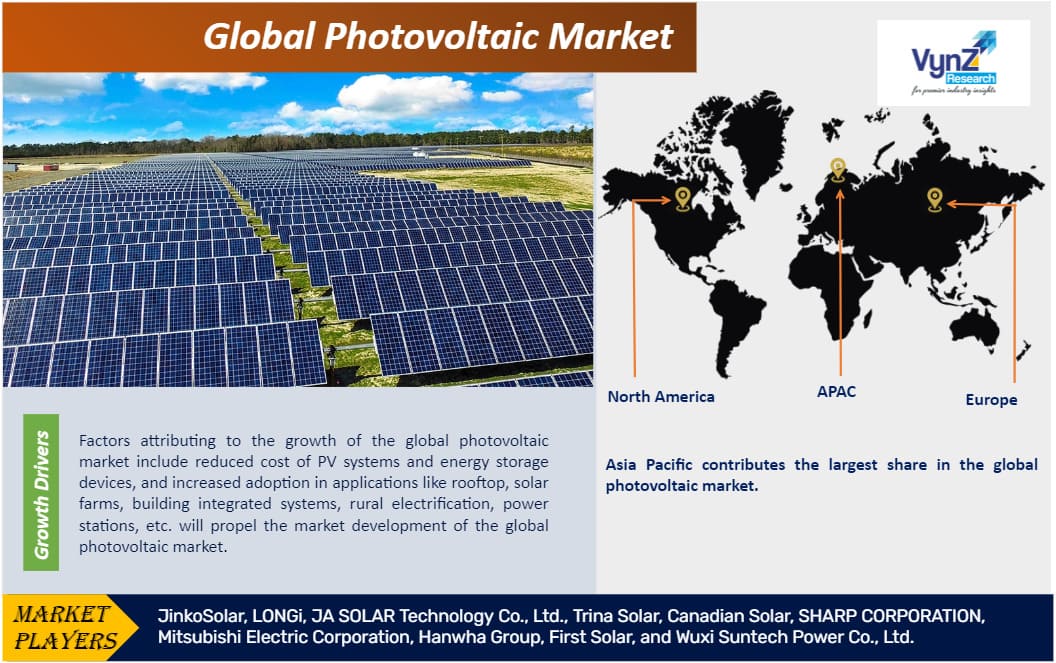| Status : Published | Published On : Dec, 2023 | Report Code : VREP3020 | Industry : Energy & Power | Available Format :

|
Page : 198 |

Global Photovoltaic Market – Analysis and Forecast (2025-2030)
Insight by Type (Modules, Inverters, Balance of System) Insight by Technology (Monocrystalline Silicon, Thin Film, Polycrystalline Silicon, Others)Insight by Grid Type (On-Grid, Off-Grid)Insight by Installation (Ground Mounted, Rooftop, Others) Insight by Application (Residential, Non-Residential, Utilities) By Geographical Segmentation North America (U.S., Canada, and Mexico),Europe (Germany, U.K., France, Italy, Spain, Russia, and Rest of Europe), Asia-Pacific (APAC) (China, Japan, India, South Korea, and Rest of Asia-Pacific), and Rest of the World(Brazil, Saudi Arabia, South Africa, U.A.E., and Other Countries)
Industry Overview
The Global Photovoltaic Market Size is expected to reach USD 156.8 billion by 2030 from USD 97.6 billion in 2023. It is expected to register a CAGR of 10.5% during the forecast period.
The photovoltaic (PV) technology refers to the process of harnessing sunlight to produce electricity by using specific components like semiconductors. This process depends on the photovoltaic effect within the semiconductors.
The process is extremely environmentally friendly way to generate electricity from a renewable source. This minimizes carbon emissions. Its distinctive from conventional energy systems and operates at a low cost.
The global photovoltaic market is divided by its type into modules, inverters, and more where the inverters are expected to grow more. It is also divided by technology and the monocrystalline silicon segment is expected to grow significant.
The market is also divided by the grid type, installation and application where the on-grid systems, ground-mounted installations segment, and residential application respective for eacg division are expected to grow during the forecast period.

Photovoltaic Market Segmentation
Insight by Type
The global photovoltaic market is divided by its type into modules, inverters, and Balance of Systems (BOS). In the forecast period, it is expected that the market share of inverters will prevail and grow at a significant rate due to the increasing utilization of PV inverters in both utility and residential settings. This is because the ability of these PV inverters to convert variable DC power from PV solar panels into AC power. The individual panel autonomy, simplified installation, enhanced fire safety, and cost-effective features contribute to the higher demand for inverters within the photovoltaic industry.
Insight by Technology
In terms of technology, the global photovoltaic market is divided into monocrystalline silicon, thin film, polycrystalline silicon, and other segments. Out of these all, the monocrystalline silicon segment leads the market and its dominance is expected to grow during the forecast period due to the prevalent adoption in rooftop solar systems and its widespread usage in large-scale installations in both residential and commercial sectors.
Insight by Grid Type
The photovoltaic market is divided by its grid types into on-grid and off-grid segments. Out of these two segments the on-grid segment is expected to grow within the forecast period due to its cost-effectiveness in operations and lower maintenance requirements. It is also due to the simplicity in integrating the system with grid-connected PV systems. These systems add to the cost-effectiveness even more due to their ability to feed excess electricity back into the grid. This eliminates the need for installation of a battery storage nearby.
Insight by Installation
According to the installation modes, the global photovoltaic market is divided into ground mounted, rooftop, and other segments. Out of these segments, the ground-mounted installation segment holds the largest market share. This is mainly due to their cost-effectiveness for utility or commercial projects. This leads to a rising number of installations due to their efficient maintenance and operation.
Additionally, rooftop installations are experiencing fast growth as the solar rooftop model poses fewer environmental pollution risks.
Insight by Application
The global photovoltaic market is divided into residential, non-residential, and utilities sectors depending on their application. Among these segments the residential segment is projected to experience a substantial growth at a high CAGR during the forecast period due to the rising adoption of PV systems on residential rooftops to generate electricity.
Additionally, the growing adoption of building-integrated photovoltaic (BIPV) systems and integration of them on the walls or roofs of new industrial and residential buildings, either as supplementary or main sources of electrical energy, will further stimulate the expansion of the photovoltaic market.
Global Photovoltaic Market Report Coverage
|
Report Metric |
Details |
|
Historical Period |
2018 - 2023 |
|
Base Year Considered |
2024 |
|
Forecast Period |
2025 - 2030 |
|
Market Size in 2024 |
U.S.D. 97.6 Billion |
|
Revenue Forecast in 2030 |
U.S.D. 156.8 Billion |
|
Growth Rate |
10.5%% |
|
Segments Covered in the Report |
By Type, By Technology, By Grid Type, By Installation, and By Application |
|
Report Scope |
Market Trends, Drivers, and Restraints; Revenue Estimation and Forecast; Segmentation Analysis; Impact of COVID-19; Companies’ Strategic Developments; Market Share Analysis of Key Players; Company Profiling |
|
Regions Covered in the Report |
North America, Europe, Asia-Pacific, Middle East, and Rest of the World. |
Industry Dynamics
Photovoltaic Industry Trends
There is a growth in the demand for inverters due to their pivotal role in converting solar panel power efficiently.
The monocrystalline silicon market segment is steadily growing due to the widespread adoption in various installations.
There is a rise in investments, driven by growing awareness of renewable energy and government incentives for solar power projects.
There is a notable emphasis on research and development activities aimed at enhancing the efficiency and durability of photovoltaic systems.
The industry is experiencing rapid technological advancements such as improvements in solar cell efficiency, energy storage solutions, and grid integration technologies.
The market is diversifying beyond traditional installations to include innovative applications such as building-integrated photovoltaics (BIPV), solar-powered transportation, and more.
Digitalization is playing a crucial role in maximizing the performance of photovoltaic systems.
Photovoltaic Market Growth Drivers
Different factors are driving the growth of the global photovoltaic market. For example, the declining costs of PV systems and energy storage solutions is resulting in higher adoption and facilitating market growth.
Growing adoption across diverse applications such as rooftop installations, solar farms, building-integrated systems, rural electrification, and power stations is also contributing to market expansion.
The increasing number of off-grid areas worldwide and higher investments in solar energy will continue to drive the growth of this market.
A few other reasons for growth include the growing emphasis on residential and commercial PV frameworks, reducing cost of PV systems, continual focus on renewable energy and its development, ongoing technological advancements, increase in solar cell production, and the growth in the number of PV installations globally.
Photovoltaic Market Challenges
A shortage of technically skilled personnel for PV installation and maintenance, high cost of installation, intermittent nature of solar energy, regulatory uncertainties, land-intensive nature of solar power projects, grid integration challenges, and supply chain disruptions are further impeding the growth of the market.
Photovoltaic Market Opportunities
The global photovoltaic market offers significant opportunities for industry leaders driven by rising demand for renewable energy, ongoing technological advancements in solar cell manufacturing, and government initiatives promoting universal electricity access. Integration with energy storage solutions, penetration into emerging markets, and expansion of distributed generation further contributes to the growth prospects of the industry.
Photovoltaic Market Geographic Overview
The Asia Pacific region holds the large share of the market. This is attributed to the existence of key players and rising adoption of PV modules, increased government investments, and energy-saving policies. This region is also the primary producer and consumer of PV modules and components.
Europe however dominated the market and is expected to do quite well during the forecast period due to rapid development of solar farms and favorable laws.
Photovoltaic Market Competitive Insight
A radical movement toward profitable new product innovations, precise manufacturing, optimization, and standardized production processes for power output, lower emissions, and affordable installation costs will have an even greater impact on the corporate landscape. Some of the crucial marketing tactics the industry participants employ to keep their place on the market include mergers and acquisitions, partnerships, new product development, business expansions, collaborations, supply contracts, agreements, and contracts. The top market participants are expanding their product offerings by developing product lines tailored to particular industries.
JA Solar, a producer of high-performance photovoltaic products, was established in 2005 and offers silicon wafers, cells, modules, and photovoltaic power stations. It has 12 manufacturing facilities and more than 20 branches worldwide. Ground-mounted power plants, commercial and industrial rooftop PV systems, and residential rooftop PV systems all frequently use JA Solar equipment. Their PV module includes a 60-cell MBB Half-cell Module, 72-cell MBB Half-cell Module, 72-cell MBB Bifacial PERC Half-Cell Double Glass Module, 54-cell MBB Half-cell Module, 60-cell MBB Bifacial PERC Half-Cell Double Glass Module, and 72-cell MBB Bifacial PERC Half-Cell Double Glass Module.
Mitsubishi Electric is a leading manufacturer of photovoltaic modules and AC-DC inverters worldwide. Mitsubishi offers Diamond Pro, Diamond Premium, Black Diamond, Neo Solar Power (NSP), and NSP Plus series. Furthermore, the 120 half-cut, four-busbar cells in the Diamond Premium monocrystalline modules (265W-280W) make them perfect for household and smaller commercial systems. Alternative aesthetic and efficiency choices are provided by the 60-cell monocrystalline Diamond Pro (265W-275W) and Black Diamond (275W-280W) modules. However, the 72-cell monocrystalline XL solar panels of the NSP (350W-360W) and NSP Plus (320W-330W) lines are specifically made for industrial and commercial installations.
Recent Development by Key Players
JA Solar (a global leader in the photovoltaic (PV) industry) has entered into a 200MW PV module distribution agreement with Exel Solar. This strengthened partnership shall enhance collaboration between the two companies and support Mexico's goal of reducing greenhouse gas emissions by 40% by 2030.
Trina Solar invested USD 200 million to build a solar modulemanufacturing facility in Wilmer, Texas. The facility shall manufacture 5GW of solar modules.
Key Players Covered in the Report
Some of the major players operating in the global photovoltaic market include JinkoSolar, LONGi, JA SOLAR Technology Co., Ltd., Trina Solar, Canadian Solar, SHARP CORPORATION, Mitsubishi Electric Corporation, Hanwha Group, First Solar, and Wuxi Suntech Power Co., Ltd.
The Photovoltaic Market report offers a comprehensive market segmentation analysis along with an estimation for the forecast period 2025–2030.
Segments Covered in the Report
- By Type
- Modules
- Inverters
- Balance of System
- By Technology
- Monocrystalline Silicon
- Thin Film
- Polycrystalline Silicon
- Others
- By Grid Type
- On-Grid
- Off-Grid
- By Installation
- Ground Mounted
- Rooftop
- Others
- By Application
- Residential
- Non-Residential
- Utilities
Region Covered in the Report
- North America
- U.S.
- Canada
- Mexico
- Europe
- Germany
- U.K.
- France
- Italy
- Spain
- Russia
- Rest of Europe
- Asia-Pacific (APAC)
- China
- Japan
- India
- South Korea
- Rest of Asia-Pacific
- Rest of the World (RoW)
- Brazil
- Saudi Arabia
- South Africa
- U.A.E.
- Other Countries
.png)
Source: VynZ Research
Frequently Asked Questions
Purchase Options
Latest Report
Research Methodology
- Desk Research / Pilot Interviews
- Build Market Size Model
- Research and Analysis
- Final Deliverabvle
Connect With Our Sales Team
- Toll-Free: 1 888 253 3960
- Phone: +91 9960 288 381
- Email: enquiry@vynzresearch.com
Photovoltaic Market
